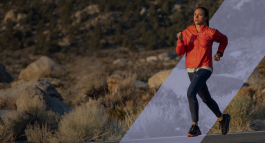How to stop chafing when running
April 21, 2021
Chafing is a very real problem. Chafing can easily ruin your run and to make things worse, it takes time to recover.
Chafing is a very real problem. Chafing can easily ruin your run and to make things worse, it takes time to recover. If you head back out a few days later, there’s a good chance you’ll be greeted by that same unwelcome pain again.
So, what can you do to stop chafing when running? This is our definitive guide to living an active and chafe-free life.
How to prevent chafing on your inner thighs when running
One of the most annoying things about chafing is that it always seems to affect such unusual spots. The nipples are undoubtedly a chafing hotspot, but so are your inner thighs.
If you suffer from inner thigh chafing, then one of the simplest solutions is to wear longer running shorts. Some runners prefer to wear trail length shorts, which tend to be longer in the inseam, while compression shorts worn under regular running shorts will prevent the friction between your thighs. You should also avoid running in shorts that have seams on the inner thigh or that are too loose and baggy. men's and women’s running tights can be an excellent option in the winter months but avoid prominent seams.
Before you wear your new running gear on a long run, you should always test drive first. If the waistband of your new shorts or the seam of your running tights is going to cause chafing, you’ll usually know about in the first 10 or 20 minutes.
How do I prevent chafing when running?
Now that we’ve resolved the particularly sore inner thigh problem, we can move onto some general tips that can be used to prevent chafing wherever it occurs.
- Create an extra layer between your skin and clothing
If you’re heading out on a long-distance run, it’s well worth spending a few minutes preparing. Creating an extra layer between your skin and workout gear is an effective way to prevent chafing that could derail your run. Although chafing is worse in wet conditions, it’s dry skin - rather than well-moisturised skin - that’s more prone to rubbing. Using moisturiser or other lotions such as petroleum jelly or hypoallergenic balm will reduce the effects of friction so you can run undisturbed.
You should cover all the usual chafing spots. That includes the inner thighs, nipples, armpits and groin. If you’re going extra long, it might even be worth carrying a travel-size tube of petroleum jelly in a pocket or waistpack in case of chafing emergencies.
- Wear clothing that wicks moisture away from the skin
Once you’ve prepped the skin to keep it moist, the next job is to choose running gear that’ll keep you dry. When skin is sweaty, it’s more likely to chafe, so you need to wear clothing that’s made from breathable, sweat-wicking materials that will actively work to remove sweat from the body.
You should also remove any tags that could rub and opt for seamless gear whenever possible. Ladies should avoid sports bras that are too snug, as they can dig into your shoulder blades and rib cage, and for men that have experienced similar problems before, it may be worth popping a couple of plasters over your nipples.
- Keep running accessories tight to your body
These days, many runners carry some form of running accessory. That could be a hydration belt when tackling long distances, a weighted backpack to burn a few more calories or an armband to carry your mobile phone. All of these accessories have the potential to cause chafing due to the friction between the straps and your skin. To stop chafing when running, make sure the straps are tight so the equipment cannot bounce or move around. It’s also worth applying petroleum jelly or some other cream to the areas of skin that are in contact with the straps.
How to treat chafing after running
Okay, so trying to prevent chafing when running didn’t work out, and you’re now left with a raw and painful rash. But don’t worry, there are a few steps you can take to ease the pain and speed up your recovery. Firstly, when you hit the shower after your run, make sure the water is lukewarm rather than hot, as that can make the burning sensation feel worse. Then use an antibacterial soap to reduce the likelihood of common infections such as folliculitis.
Once you’re out of the shower, dab the affected area dry and apply an antibacterial ointment to soothe the irritated skin. Then slip on some comfortable, non-clingy clothes to let your skin breathe and make sure you follow this guide to stop chafing when running next time!
